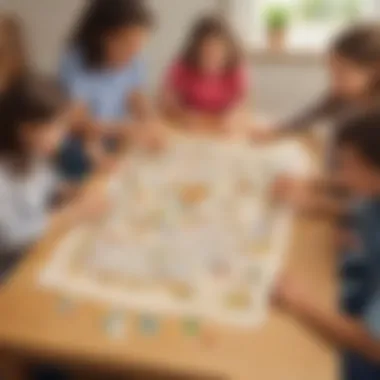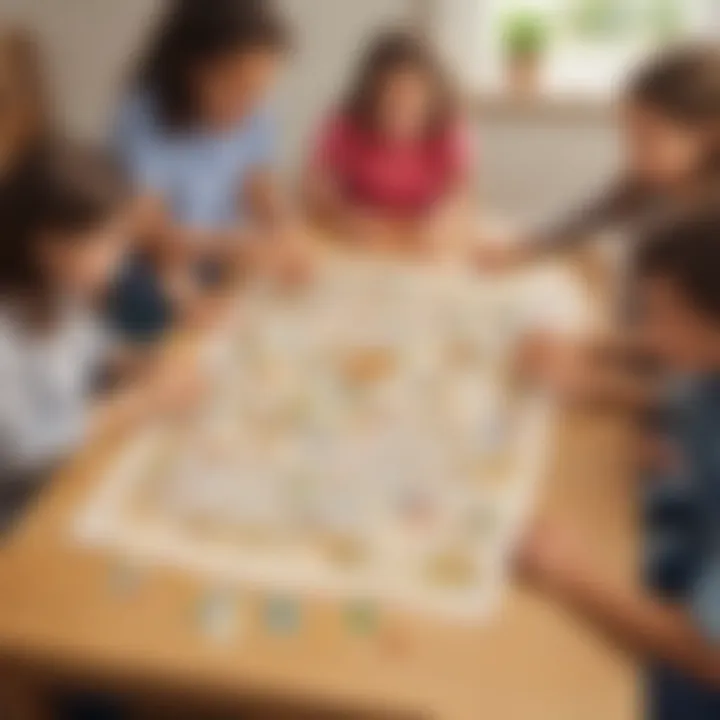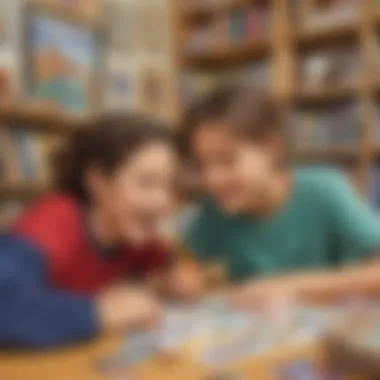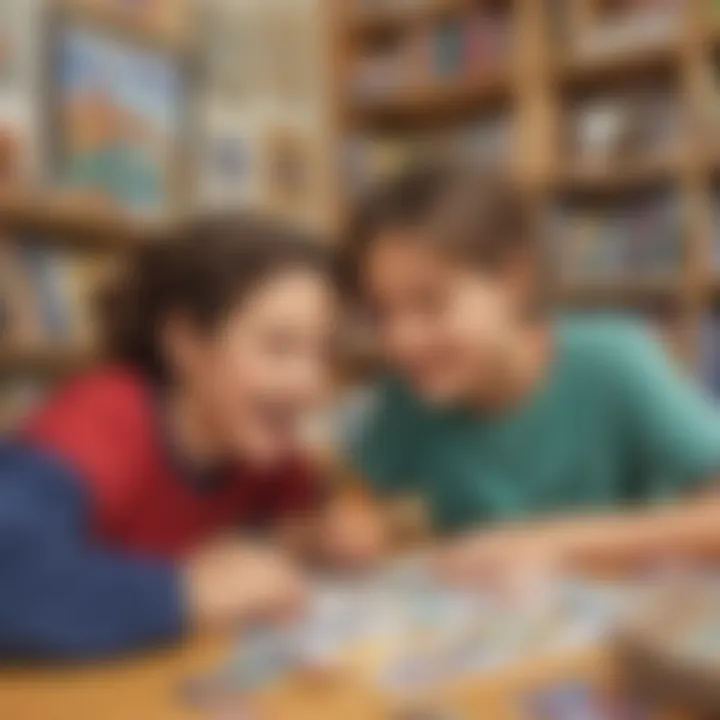Engaging Language Learning Through Word Games


Intro
Creating a word game for elementary school children is not only a fun endeavor but also a crucial educational tool. Word games play an essential role in developing language skills, fostering critical thinking, and enhancing creativity among young learners. In the upcoming sections, we will explore effective strategies for game mechanics, craft ideas, and quiz topics that engage children in a learning experience that feels effortless and enjoyable. This guide will serve educators, parents, and caregivers who wish to harness the power of interactive play in language learning.
Creative Activities
Word games can be supplemented with creative activities that enhance the learning experience. Engaging children in hands-on tasks can reinforce the concepts learned through the games. Crafting encourages children to express their understanding and apply new vocabulary in a tangible way.
Craft Ideas
Some craft ideas suitable for elementary school-aged children include:
- Word Collages: Children can cut out words from magazines or newspapers and arrange them to form a thematic collage.
- Homemade Flashcards: Using colored paper, children can create flashcards for new vocabulary words.
- Story Stones: Painting stones with pictures representing different words can lead to imaginative storytelling activities.
Step-by-Step Guides
- Creating a Word Collage:
- Homemade Flashcards:
- Gather materials like magazines, scissors, glue, and a large sheet of paper.
- Encourage children to find words that relate to a specific theme, such as animals or emotions.
- Once all words are collected, have them glue them onto the paper in an organized manner.
- Discuss the collected words and their meanings, promoting vocabulary retention.
- Cut colored paper into squares.
- Write a word on one side and a corresponding image on the other.
- Use these flashcards for various games, such as memory matching or quick draw.
Educational Value
Engaging in these activities promotes not just linguistic skills but also fine motor skills and cognitive abilities. Children learn to categorize words, explore their meanings, and engage in discussions about their creations, all of which allow for a deeper understanding and retention of language.
Fun Quizzes
Quizzes serve as an excellent method to reinforce learning and assess progress in a light-hearted way. They can also introduce an element of competition that can motivate young learners. In schools, integrating fun quizzes into lessons can enhance retention and comprehension.
Quiz Topics
On platforms like ElemFun, various quiz topics are available, including:
- Synonyms and antonyms
- Vocabulary from popular children's literature
- Basic grammar skills
- Spelling challenges
Question Types
To maintain engagement, quizzes can use diverse question types, such as:
- Multiple choice
- Fill-in-the-blank
- True or false
- Matching words with definitions
Knowledge Reinforcement
Quizzes not only reinforce knowledge but also allow children to assess their understanding in a non-threatening environment. They can track their progress through scores and feedback, fostering self-awareness in their learning journey.
Fact-Based Articles
In addition to games and quizzes, fact-based articles can provide a broader context for children's learning. These articles can cover a range of topics that pique their curiosity.
Topics
The articles might address:
- Nature and science
- Historical anecdotes
- Cultural traditions
Engaging Content
The content should be presented in a clear and engaging manner, using simple language that is comprehensible at an elementary school level. Incorporating visuals can also enhance understanding and retention.
Foreword
The formation of word games specifically for elementary school children plays a pivotal role in language learning. These games not only entertain but also serve as effective tools for education. Word games engage young minds in a way that traditional teaching methods may not. They particularly focus on developing vocabulary, spelling, and critical thinking skills, essential at this foundational stage of education.
Defining Word Games
Word games can be described as structured forms of play that require players to engage with language in a dynamic and interactive manner. They include a variety of formats, such as puzzles, quizzes, and board games. Each format encourages the manipulation of letters, words, and phrases. Players might engage in activities like creating words from given letters, solving clues to find words, or filling in missing letters in a word. These games tap into the playful nature of children while promoting important language skills, making them an ideal addition to educational settings.
Importance for Elementary Education
In the realm of elementary education, the significance of word games cannot be overstated. They serve multiple purposes. For one, they make learning enjoyable. When children find pleasure in learning, they are more likely to retain information.
Furthermore, these games facilitate social interaction. Children learn to play cooperatively or compete with peers, developing not only language skills but also communication and teamwork abilities. The cognitive challenge presented by word games enhances critical thinking. Students learn to analyze word structures, which improves their spelling and vocabulary.
"Engaging word games in the classroom fosters a love for language, nurturing skills that will last a lifetime."


In summary, incorporating word games into education provides a structured yet flexible format for children to explore and learn language. It nurtures their curiosity while supporting the development of essential skills.
The Educational Value of Word Games
Word games hold a significant place in the realm of language learning, particularly for elementary school children. These games serve more than just entertainment; they are powerful educational tools that foster various skills essential for child development. By focusing on vocabulary enhancement, spelling improvement, and critical thinking, word games provide a structured yet enjoyable way for children to engage with language. This section delves into the specific educational benefits of word games, highlighting their relevance and potential impact on young learners.
Enhancing Vocabulary Skills
Enhancing vocabulary skills is perhaps one of the most vital benefits of incorporating word games into learning. Through engaging activities, children are exposed to diverse words in a context that makes learning fun. For example, when playing games like Scrabble or Boggle, children encounter new terms that they may not come across in traditional classroom settings. This exposure is crucial in building a robust vocabulary.
Moreover, word games encourage repeated exposure to vocabulary within various contexts, increasing retention and understanding. Children learn not just individual words, but also synonyms and antonyms, fostering a deeper understanding of language nuances. When children actively engage in word games, they often look up meanings or ask about unfamiliar words, further enhancing their curiosity and improving language comprehension.
Promoting Spelling Proficiency
Spelling proficiency is another key aspect enhanced by word games. Games such as crosswords or spelling quizzes compel children to recognize and spell words correctly. When children face challenges within these games, they actively work towards solving them, which reinforces their spelling abilities. For instance, in a game like Hangman, players must think critically about letter placements and word structures, contributing directly to their spelling skills.
Additionally, word games often incorporate various rules or themes related to spelling patterns. This can help children discover regularities in words, improving their spelling intuitively. Over time, as they encounter words in different formats, their spelling competence increases, leading to more effective written communication.
Encouraging Critical Thinking
Word games inherently include elements that stimulate critical thinking. As players strategize, they must analyze letters or clues, making decisions based on limited information. This process of deduction and reasoning sharpens cognitive skills, which are vital in various academic areas beyond language learning. For instance, during a game of word search, a child may need to visualize the placement of words and determine paths without linear constraints. This enhances their problem-solving capabilities.
Moreover, critical thinking extends beyond just identifying words; it fosters creativity as children begin to explore their thought processes. When children formulate responses to game challenges, they engage in cognitive flexibility, which prepares them for more complex decision-making in life. This is particularly beneficial as they grow, facing more challenging academic and social environments.
"Word games are not just fun; they are essential tools for developing language and critical skills in young learners."
In summary, the educational value of word games transcends mere recreational aspects. They serve as mechanisms for improving vocabulary, spelling, and critical thinking in an engaging, interactive format. By embedding these games into the learning experience, educators and parents can significantly enhance children's linguistic abilities while keeping them engaged and motivated.
Game Mechanics and Design
Game mechanics and design play a crucial role in the development of word games. They directly influence how players interact with the game and, ultimately, their overall learning experience. Understanding these elements is essential for creating engaging and effective word games that foster language skills. The mechanics involve rules, player interactions, and the overall flow of the game. Designing a game with thoughtful mechanics can encourage children to explore language in a playful manner, while also maintaining educational focus.
Types of Word Games
Crossword Puzzles
Crossword puzzles are classic word games that help enhance vocabulary and improve spelling. The key characteristic of crossword puzzles is their grid layout, where players fill in words based on provided clues. This format encourages critical thinking, as players must connect clues to words they know.
One unique feature of crossword puzzles is the combination of horizontal and vertical clues, which creates a more dynamic learning environment. They can be tailored to different skill levels, making them a flexible choice for educators. While crossword puzzles are beneficial for vocabulary expansion, they may pose challenges for younger children who might struggle with clue interpretation.
Word Searches
Word searches are another popular choice among word games. The main aspect of word searches is their straightforward format, where players look for specific words hidden within a grid of letters. This type of game contributes to language learning by focusing on word recognition and spelling.
The simplicity of word searches makes them accessible to a wide range of age groups. Children can engage with new vocabulary in a low-pressure setting. However, one disadvantage is that word searches might not encourage deeper understanding of the words or their meanings, making them less effective for more advanced language skills.
Scrabble Variants
Scrabble variants introduce a more strategic approach to word games. These games usually involve forming words on a game board using lettered tiles, allowing for creativity and competitiveness. A key characteristic of Scrabble variants is their point system, which incentivizes players to think critically about word choices and opportunities on the board.
One unique feature of Scrabble variants is the social interaction they promote. Players often work collaboratively or competitively, adding a social dimension to language learning. However, the complexity of the gameplay can be a challenge for younger players, requiring support from adults or more experienced peers.
Elements of Game Design
User Engagement
User engagement refers to how well players connect with the game content and mechanics. A high level of engagement can significantly enhance the educational value of word games. Key characteristics of user engagement include interactive elements and immersive gameplay. Games that capture interest lead to better retention of language skills.
Striking a balance between education and entertainment is essential. Engaging games motivate children to play longer, enhancing vocabulary and critical thinking. However, if a game becomes too complex or isn't enjoyable, engagement might decrease, limiting educational benefits.
Challenge Levels
Challenge levels are critical in maintaining player interest and fostering skill development. The key aspect is ensuring that the difficulty aligns with the player's abilities. Games can offer various challenge levels to accommodate different learners. This adaptability helps keep children motivated as they gradually take on more difficult tasks.
The advantage of well-designed challenge levels is that they can push learners to improve. However, if the challenges are too difficult, players may feel frustrated, leading to disengagement. Striking the right balance is key to promoting effective language learning through gameplay.
Feedback Mechanisms
Feedback mechanisms provide players with information about their performance during the game. Effective feedback can reinforce learning by highlighting success and guiding improvement. Key features of feedback mechanisms include instant scoring or hints and rewards for achievements.
Constructive feedback helps maintain interest and encourages players to keep learning. It can also help track vocabulary growth over time. However, if feedback is vague or absent, players might not understand their progress, potentially diminishing their interest in the game.
Well-structured feedback not only enhances the gaming experience but also fosters a deeper understanding of language concepts.
Implementation Strategies


Implementation strategies are vital in developing a word game. They ensure that the game is not only fun but also educational. By carefully considering how to incorporate the game into the learning process, educators can increase its effectiveness. A well-structured implementation plan can lead to improved student engagement and better learning outcomes. It also allows for flexibility in adjusting to the needs of different learners, making the experience more inclusive and beneficial.
Creating a Safe Learning Environment
Safety in the classroom promotes open communication and participation. A welcoming space encourages children to explore and learn without fear. Here are a few elements to consider when creating a safe learning environment:
- Encourage Positive Interactions: Teachers should model respectful behavior and encourage students to support one another. This helps build trust.
- Set Clear Expectations: Create clear rules around gaming sessions. Students should know what is acceptable behavior.
- Celebrate Mistakes:
Mistakes should be seen as learning opportunities, not failures. Encouraging this mindset will reduce anxiety about participation.
In creating an environment that prioritizes safety, the game becomes a tool for fostering confidence and creativity.
Incorporating Games into Curriculum
Integrating games into the curriculum provides opportunities for active learning. Word games can reinforce language skills while making the process enjoyable. Here are effective methods for doing so:
- Align with Learning Objectives:
Ensure that the game addresses specific educational goals. For example, a spelling game can target vocabulary from recent lessons. - Flexible Use Across Subjects:
Word games can be adapted for various subjects. For instance, they can be used in history to learn important terms, or in science to memorize definitions. - Utilize Technology:
Digital platforms can facilitate gameplay. Online resources allow for remote play and can be tailored to suit individual educational needs.
It is essential that teachers find ways to weave games into their regular teaching routines. This helps solidify the learning and keeps students engaged.
Adapting Games for Different Learning Styles
Adapting games for different learning styles is crucial in making word games enjoyable and effective for all elementary school children. Understanding that not all children learn the same way allows educators and parents to create more inclusive learning experiences. By tailoring word games to various learning preferences, such as visual, auditory, and kinesthetic styles, we increase the potential for engagement and retention of language skills. This strain of personalization can lead to deeper understanding and a more significant emotional investment in the learning process.
Visual Learners
Visual learners absorb information best through visual means. When developing word games for these children, incorporating colorful images, diagrams, and written words is essential. For example, a word search can include vibrant pictures related to the vocabulary words hidden within. Similarly, using flashcards with appealing designs that correlate pictures and words can enhance their learning experience. Also, visually engaging formats, such as highlighting letters in different colors, may assist in pattern recognition and vocabulary connection.
"Colorful visuals can make learning feel like an adventure rather than a chore."
Activities such as drawing the meaning of a word or a word scavenger hunt around the classroom can stimulate visual learning further.
Auditory Learners
Auditory learners thrive on listening and speaking activities. Therefore, when designing word games for these learners, incorporating elements that rely on sounds and speech is vital. A game like Hangman can be utilized with a twist: instead of guessing the letters silently, players can only guess verbally, practicing pronunciation at the same time. This twist provides a social element as players engage in dialogue.
Moreover, songs or rhymes containing new vocabulary can be integrated into play. Creating a game where learners match sounds to corresponding words can enhance retention. Recording voices saying new words can also help auditory learners connect sounds with meanings in a playful format.
Kinesthetic Learners
Kinesthetic learners gain understanding through movement and hands-on experiences. For these children, incorporating physical activity into word games can be very beneficial. The game of "Charades" can be adapted to include vocabulary words, where learners act out words while others guess them. This method interlaces physical movement with vocabulary learning.
Additionally, scavenger hunts that involve finding objects associated with specific words can leverage their active nature. Another idea is a game that uses physical letters, such as letter blocks, where learners create words on the floor. These approaches not only support learning but also engage children physically and mentally, catering to their innate desire for movement.
Examples of Popular Word Games
Understanding popular word games is key for anyone designing a language learning tool. Knowing what works and what captures children's interest provides valuable insight for educators and parents. Several games have gained enduring popularity, and they offer unique benefits for language development. By using examples of successful games, one can draw inspiration for creating new ones. This section will cover classic games as well as modern digital variants, both of which have distinct features that encourage learning.
Classic Games
Classic word games have stood the test of time, and their simplicity often makes them engaging for children. Games like Scrabble, Boggle, and crossword puzzles are not only enjoyable but also educational. Each game fosters vocabulary growth and helps improve spelling skills in an interactive manner.
- Scrabble: This timeless board game involves forming words on a grid using letter tiles. It emphasizes strategic thinking and vocabulary enhancement. Players learn new words through in-game exploration.
- Boggle: In this quick-paced game, players aim to discover as many words as possible on a grid of letters. Speed and pattern recognition are crucial here, enhancing cognitive agility.
- Crossword Puzzles: These puzzles challenge players to fill in words based on given clues. They promote critical thinking and comprehension, as players must understand definitions and synonyms.
Classic games, while traditional, also have opportunities for modern twists. For example, educators can adapt Scrabble with themed words or age-appropriate vocabulary. Additionally, games can be modified to encourage teamwork, making learning more dynamic.
Modern Digital Variants
Digital word games have emerged as a powerful tool for language learning, especially in an age where technology engages children differently. These games offer accessibility and often include interactive features that capture interest. Apps and websites like Words With Friends, Wordament, and online crossword platforms provide varied experiences.
- Words With Friends: This online game blends Scrabble mechanics with social interaction, allowing players to compete with friends. It encourages vocabulary expansion while also deepening social connections.
- Wordament: A fast-paced game that engages players in word search challenges. Its competitive nature drives engagement and sharpens word recall skills.
- Online Crossword Platforms: Websites provide interactive crossword puzzles that can be customized. They allow for flexibility in learning and can be tailored to specific vocabulary needs.
Modern digital variants offer distinct advantages such as immediate feedback, analytics on performance, and the chance to integrate with social media platforms for additional engagement. This interactivity not only motivates learners but also makes language acquisition enjoyable.
In summary, familiarizing oneself with examples of popular word games helps in understanding the landscape of language learning strategies. Both classic and modern variants provide invaluable opportunities for learners, combining fun with educational benefits.
Assessment of Learning Outcomes
Assessment of learning outcomes plays a crucial role in understanding the effectiveness of word games in educational settings. It is through this assessment that educators can evaluate whether the intended educational goals are being met. This evaluation often centers on two key factors: vocabulary growth and the overall engagement of students. By examining these elements, one can gather insights into how well a word game supports language learning and fosters an engaging atmosphere for young learners.
Measuring Vocabulary Growth
Vocabulary growth is a primary indicator of a word game’s success in promoting language learning. When children interact with word games, they frequently encounter new words and phrases, which they must decode and memorize. Tracking this growth involves various methods and tools. Among the simplest techniques is pre- and post-game testing, where educators can assess a child's vocabulary before and after gameplay.
Additionally, educators can analyze the frequency and context of new word use during gameplay. Such observations help determine which words have been effectively learned and retained. Word lists can be created from games to illustrate acquired vocabulary, providing tangible proof of growth over time.
For example, using a table may help to visualize the change in vocabulary:


| Game Played | Vocabulary Before | Vocabulary After | | Scrabble | 50 words | 75 words | | Crossword Puzzle | 45 words | 70 words |
Regular assessment encourages children to pay closer attention to their vocabulary, which not only reinforces their learning but also builds confidence in their language skills. By ensuring that games are aligned with vocabulary objectives, educators can enhance this aspect effectively.
Evaluating Engagement and Enjoyment
Engagement and enjoyment are essential factors in the positive reception of word games among elementary children. The more engaged they are, the more likely they will participate actively and benefit from the learning experience. To evaluate this, educators can employ various strategies, such as observing behaviors during gameplay or administering surveys to gather student feedback.
Surveys can ask questions like:
- Did you enjoy playing the game?
- What part of the game was your favorite?
- Would you like to play this game again?
Understanding the emotional response from students provides valuable insights. A high level of enjoyment often correlates with increased learning outcomes, as children who find learning enjoyable are typically more motivated. This allows educators to adjust gameplay elements, strike a balance among educational content, challenge, and fun, ensuring that children remain engaged throughout the process.
Effective word games do not merely teach vocabulary; they create a lively environment for exploration and creativity.
Overall, continuous assessment and evaluation are essential in the development and implementation of word games. These assessments not only help in tracking vocabulary growth but also ensure children’s engagement remains high, thereby making learning an enjoyable journey.
Challenges in Creating Word Games
Creating word games for elementary school children presents unique challenges. These obstacles can hinder the game’s success or its capacity to engage young learners. It is crucial to address these challenges thoughtfully. The aim is to ensure that the designed games provide a balance between enjoyment and educational effectiveness.
Balancing Difficulty and Fun
One significant hurdle in game design is striking the right balance between difficulty and fun. If a game is too easy, children may become bored quickly. This leads to a lack of interest in playing the game again. On the other end, if the game is too challenging, children might feel frustrated and disengaged. Therefore, careful calibration is necessary.
This balance can be achieved in various ways. Incorporating levels of difficulty allows a gradual increase in challenge, ensuring that learners remain engaged. Simple quizzes or puzzles that can be solved quickly may serve as a warm-up. Gradually, the game can introduce more complex words or challenging scenarios to maintain engagement.
Also, providing immediate feedback is important. It can boost motivation by celebrating small victories, guiding children when they make mistakes. This positive reinforcement is essential in sustaining interest.
Ensuring Educational Value
Another challenge is ensuring the educational value of the word game. The primary goal is to assist children in developing their language skills effectively.
To address this concern, game designers must integrate targeted vocabulary and spelling challenges into the gameplay. For instance, a game can focus on specific word categories, such as nouns, verbs, or adjectives, to reinforce learning. Each game should align with educational standards and learning objectives appropriate for the child's age group.
Furthermore, it's important to assess the game’s impact on learning outcomes. Educators can develop metrics to measure vocabulary growth and the development of critical thinking skills as children play. These assessments should be straightforward, allowing teachers or parents to track progress easily.
In addition, ensuring that the game accommodates different learning styles is vital. This diversification can enhance educational outcomes, making sure children from various backgrounds and with varied preferences find value in the games.
"The objective of designing effective word games goes beyond just fun; it involves creating pathways for learning that cater to a child's needs and interests."
Overall, while challenges exist in creating word games, thoughtful design can yield fantastic results in engaging young learners. Using these strategies, educators and game developers can craft experiences that inspire and educate.
Future of Word Games in Education
The future of word games in education holds significant promise. As technology evolves and pedagogical methods shift, there is an increasing recognition of the multifaceted benefits these games bring to language learning. Word games can enhance vocabulary acquisition, support spelling skills, and promote critical thinking, all in a playful context.
The rise of gamification in learning environments exemplifies this trend. Gamification refers to the integration of game designs in non-game contexts. When educators incorporate game-like elements into classroom activities, they can motivate students in ways that traditional teaching sometimes fails to achieve.
Key benefits of incorporating word games into educational settings include:
- Motivation and Engagement: Students are more likely to participate wholeheartedly in a lesson when it feels less like work.
- Interactive Learning: Word games foster collaboration among peers, enhancing social skills.
- Encouragement of Creativity: Many word games require creative thinking, which can improve problem-solving abilities.
Trends in Gamification
Gamification is reshaping educational landscapes. It introduces competition and rewards that resonate with young learners. In recent years, educators have begun utilizing technology platforms that facilitate word games. These platforms often come equipped with analytics that help track student progress.
Some trends to note:
- Digital Game-Based Learning: More schools are incorporating digital platforms designed for word game interaction. Students use tablets or computers, engaging in real-time word challenges.
- Adaptive Learning Technologies: These tools modify word challenges based on individual student performance, catering to various learning paces and styles.
- Social and Cooperative Dynamics: Many games now encourage multiplayer interactions, fostering teamwork and communication skills among students.
Technology Integration
The integration of technology in education enhances the effectiveness of word games. Devices like smartboards, tablets, and computers make the learning experience more dynamic. By utilizing applications like Wordament or Duolingo, teachers can provide students with engaging content tailored to their learning needs.
Benefits of technology integration in word games include:
- Immediate Feedback: Many digital games provide instant feedback, allowing students to learn from mistakes swiftly.
- Accessibility: Technology makes word games more accessible, including for students with diverse needs. Digital adjustments can be made to cater to varying capabilities.
- Extended Learning Opportunities: Online word games mean that learning can occur outside the classroom, encouraging continuous language practice at home.
"The fusion of technology and education can serve as a catalyst for significantly improving language skills among young learners."
Ultimately, the future of word games in education suggests a shift towards a more interactive, exciting, and personalized approach to learning. As educators and parents embrace these changes, students will benefit from enhanced language skills in a playful, meaningful manner.
The End
The completion of this article emphasizes the role of word games in fostering language development for elementary school children. These games are not merely for entertainment; they serve a structured purpose in enhancing vocabulary, promoting spelling proficiency, and encouraging critical thinking. Each section outlined in this article illustrates a specific aspect of how word games can be tailored to cultivate essential skills in a dynamic learning environment.
Summary of Key Points
In summary, several key points arise from our exploration:
- Importance in Education: Word games play a crucial role in elementary education. They provide an enjoyable way to engage children with language and support various learning styles.
- Game Mechanics Matter: Understanding different types of word games and their design elements is essential to create engaging learning experiences. Word games should balance challenge and fun to be effective in education.
- Implementation Strategies: Integrating word games into the curriculum can transform teaching methods. It is imperative to ensure a safe learning environment where kids feel comfortable to explore and learn.
- Assessment and Adaptation: Lastly, assessing the outcomes of word games ensures they meet educational objectives. Adapting games for diverse learning styles also increases their effectiveness.
Encouraging Continued Exploration
Encouraging educators and parents to delve deeper into the world of word games is vital. The landscape of education is evolving, and word games can be a versatile tool in language learning. By experimenting with various game formats and adapting them to specific learning needs, we can create more enriching experiences for children.
Further exploration could include:
- Investigating digital platforms that offer interactive word games.
- Participating in workshops that focus on gamification in teaching.
- Sharing experiences with other parents and educators to foster community learning about effective game usage.







